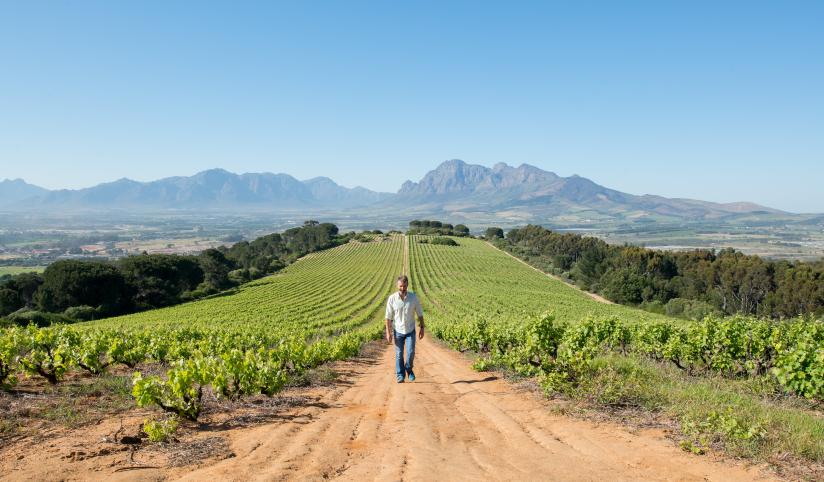Vignobles étrangers
South Africa, a travel diary in Swartland
This article was originally published in Spring 2017, R&B n°124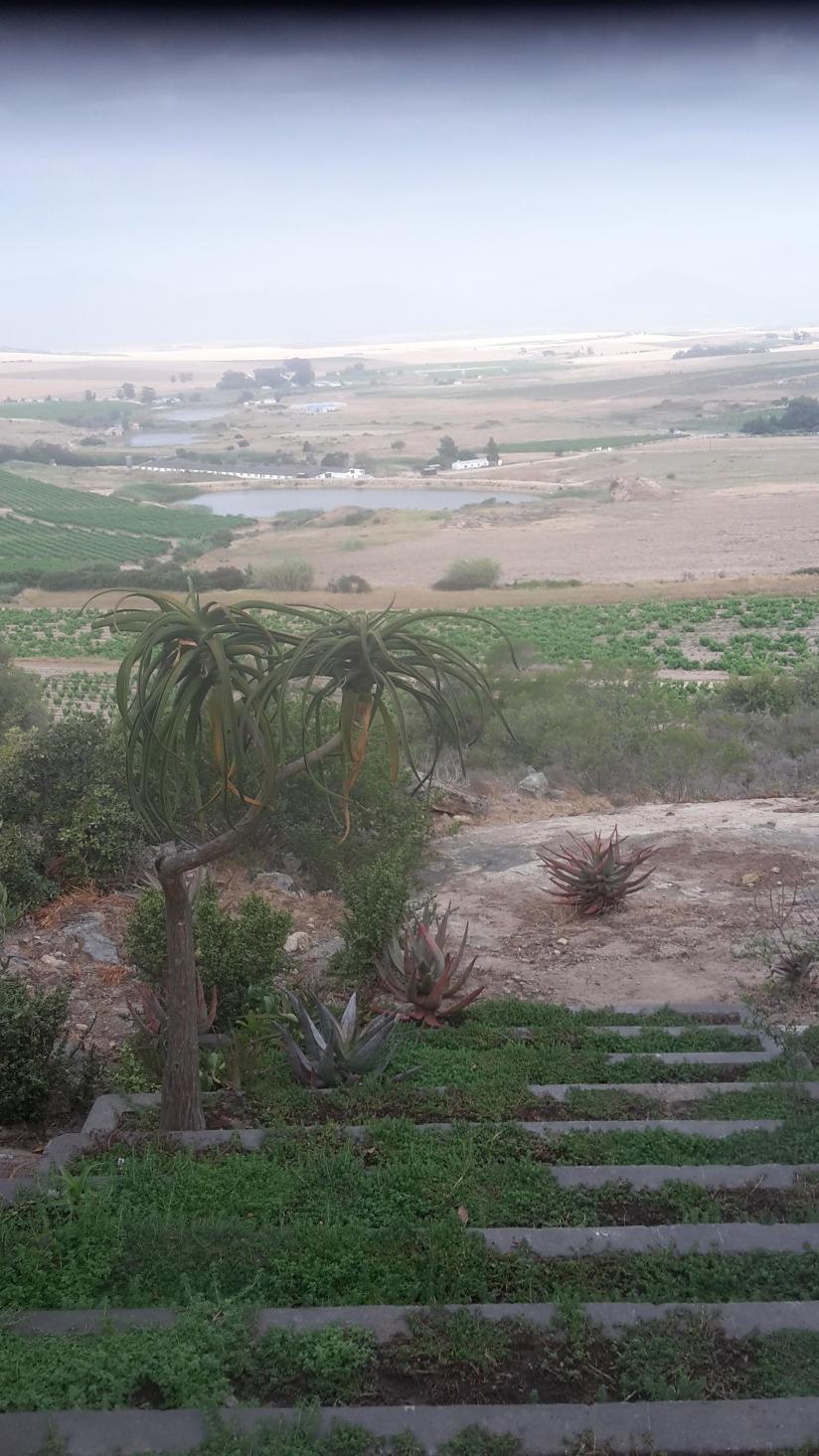
SOUTH AFRICA > COASTAL REGION > SWARTLAND & STELLENBOSCH
Located at the southern tip of Africa, the Republic of South Africa covers 1 233 404 km² (a little more than twice the size of France). Bordered by the Indian Ocean and the Atlantic Ocean on three of its sides, the country borders on the north, from west to east, with Namibia, Botswana, Zimbabwe and Mozambique. South Africa has three capitals: Cape Town (legislative capital), Pretoria (administrative capital) and Bloemfontein (capital), but Johannesburg, the largest city, is the economic capital. A democratic government has been in place since 1994, an evolution made possible by the end of the apartheid policy in 1991.
South Africa has 55 million inhabitants, 80% of whom are black, 9% of whom are Colored People, 8.5% white and 2.5% Asian. Eleven official languages can be spoken including English, Afrikaans and Zulu, which is the most common mother tongue in South African homes.
Equality of income between different groups of the population has not progressed since the end of apartheid. Nevertheless, the South African society, among the most unequal in the world, has one of the most developed economies of the continent, with infrastructure covering the country as a whole, which is divided into nine provinces, including that of the Western Cape, where almost all vineyard.
An old vineyard in a new country
With 132,000 ha of vines (an area equivalent to Bordeaux vineyards) and production of 11.2 million hectoliters, South Africa is the ninth largest wine producer in the world. Although often associated with the New World wine countries, it actually has a relatively old vineyard whose first plantations date from Jan van Riebeeck, governor of the Dutch East India Company, with a first harvest in 1659.
Then, at the beginning of the eighteenth century, thanks to Huguenot immigrants in particular (French Protestants), the culture of the vines progressed east of the city of Cape Town towards the localities of Stellenbosch, Paarl and Franschhoek. The notoriety of the South African vineyard was established at the end of the 18th century with the export of the wine of Constance, a sweet white wine. This first period of prosperity stopped during the second half of the nineteenth century when the rupture of commercial agreements with Great Britain and the appearance of a phylloxera epidemic around 1880. In 1918, the creation of the Koöperatieve Wijnbouwers Vereniging (KWV), a cooperative grouping 95% of the country's producers, allows structuring the wine sector without adopting a truly qualitative approach, the yields per hectare remaining high. In addition, apartheid is a serious impediment to quality viticulture, and the real renaissance of the South African vineyard, one of the northernmost in the southern hemisphere, dates from the early 1990s.
The oldest rocks of the greater Cape region were formed in Precambrian, between 540 million and 1 billion years before our era. In the Cambrian region - about 500 million years ago - granitic formations have metamorphosed the surrounding layers, giving rise to shales, granites ... The South African vineyard is therefore essentially based on schistose, granitic and sandstone soils. foot of mountains, and sandy-clay or alluvial plain. The most planted varieties are, in red, cabernet sauvignon and syrah and, in white, chenin with very high yields in structures selling in bulk or producing for distillation.), chardonnay and sauvignon.
The South African vineyard can be divided into large wine-growing regions subdivided into districts that break down into "Wards", the smallest category of wine appellations. There is no AOC system as in France, the wine regions of South Africa being defined in the framework of the "Wine of Origin" (abbreviation WO) decree of 1973. All "wines of origin" must be produced on the basis of grapes from their region of production without particular criteria or constraints of grape varieties, cultural practices or winemaking methods.
For example, the province of Western Cape, South Africa's main wine-growing zone, is divided into five regions: Coastal Region, Olifants River Region, Breede River Valley Region, Klein Kardoo Region and a region of independent districts, including Walker Bay.
The Coastal Region, which is of particular interest to us, is divided into seven districts: Cape Point, Stellenbosch, Paarl, Tullbach, Tigerberg, Darling and Swartland. For example, Franschoek Valley is a Ward in Paarl District.
In addition to the reinvestment of the historic stone towns of Stellenbosch and Paarl, the vineyard is also expanding to the Olifants River and Breede River areas, but with mass production on irrigated vines.
Today, the types of structures in the South African vineyard are mainly:
- cooperatives that can be compared to ours, bringing together producers around a winemaking and marketing organization;
- traders, operating close to that of French or European traders;
- "Estates", bottling areas, like castles in Bordeaux. Farms produce grapes but do not always vinify themselves, the harvest can be sold. However, the "Estates" can dispose of some of the wine from their harvest to sell under their own brand;
- "Wineries" who may own some of their vineyards but also buy grapes from other producers in order to vinify and market them under their own label. Their mode of operation is similar to that of the Estates.
Our trip took place especially in the district of Swartland and incidentally on that of Stellenbosch and Paarl who would certainly have deserved more time.
Swartland and Swartland Revolution
Beginning sixty kilometers north of Cape Town, this vast region whose name in Afrikaans means "Black Earth" traditionally provides cereals, but also houses many vineyards, often old and very small, non-irrigated, cut in cup and posed on the mountainside. The climate is Mediterranean, dry and warm (one of the warmest in the vineyard) and the vine is rarely affected by fungal diseases. Low rainfall greatly reduces yields that rarely exceed 20 hl / ha. Cup size increases the resistance of grapes to water stress and heat. The soil, often composed of shale, from where the name "Malmesbury shale" (shale is the English word for schist) from the eponymous town in the south of the region, also contains granite especially in the region of Paardeberg.
Grouped within the "Independent Producers of Swartland", some being called revolutionary, the founding members had launched in 2010 the "Swartland Revolution". Until 2015 (edition we attended), this annual event in Riebeek-Kasteel, in November - ie in the middle of the austral spring - gathered many participants, from the region or elsewhere, in particular Vincent Carême vouvrillon winegrower, attentive observer and involved in the local vineyard (his wife is South African). Throughout the small town and especially at the Royal Hotel, the oldest hotel in the country with quaint charm, everything was organized around wine and gastronomy. In addition to numerous conferences / tastings, one could taste the latest creations of each, as well as experimental productions or limited series. A large convivial and watered dinner, gathering all the participants, closed the first day. As the change began, the founding members felt that they had to move on, take another step.
Stellenbosch
The wines of this district are undoubtedly the best known and most exported from South Africa. The University of Stellenbosch is the only university in the country to have an education and research department dedicated to viticulture and winemaking, which also contributes to the reputation of the vineyard. It is located at the southwestern tip of the country east of Cape Town, very slightly inland, but not far from the Atlantic Ocean whose sea entrances regulate the heat. The fairly high temperature range in summer ensures good maturity of the grapes. In addition, the volume of rainfall often prevents the use of irrigation.
The soils are rather complex with schists and granites outcropping, interspersed with sandstone sand and alluvia from the rivers. The edges of the hills surrounding the Simonsberg, among others, are considered qualitative.
Here, red wines dominate, with cabernet sauvignon, syrah, merlot and pinotage, a cross between cinsault and pinot noir created at the University of Stellenbosch in 1925. In white wines, especially chenin, Chardonnay and Sauvignon.
The generally traditional methods of cultivation (of the type "reasoned fight") and the method of vinification are similar to what is commonly practiced in the greater Bordeaux region, with a few exceptions. A dynamic policy of wine tourism also accompanies the development of this very popular district.
The estates that we selected
This trip was mainly organized in November 2015 around the Swartland Revolution, the visits of domains present at this event were therefore privileged. Nevertheless, before and during the stay in Stellenbosch, contacts were made, and properties seen in this district as well as in Paarl. Only the most significant entities with different titles, viticulture, are mentioned, wines, situation, structure or mode of operation, even notoriety. However, it must be recognized that these areas are quite atypical, reflecting neither the practices nor the techniques generally observed in this country.
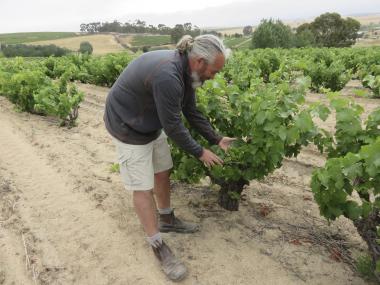
In Swartland
AA Badenhorst Family Wines
Adi Badenhorst manages this 28 ha estate located about 100 km north of Cape Town, in Kalmoesfontein precisely, in the Paardeberg mountain. One arrives there after having left an asphalted road and rolled about ten kilometers on a deserted track in laterite, without houses in the neighborhoods. Terminus on a farm adjoined to ancillary buildings to accommodate visitors or friends, South African hospitality is not a word. Change of scenery assured, with a feeling of being at the end of the world, in an unknown universe, but it is easy to find the winery ... to sound. Indeed, Adi Badenhorst, a warm, frank and direct man, about forty, likes to work in team and music, especially that of the 1970s or 1980s, which does not prevent him from taking very heart his job as a winemaker. A real pleasure to drink his coffee, in the morning in the cellar, to the music of his youth!
Coming from a family of winegrowers, Adi studied viticulture and chemistry at the agricultural institute of Elsenburg (Stellenbosch district), followed courses, worked during the grape harvests and vinified in Bordeaux and Bordeaux. North Rhone. For nine years he was also the winemaker of a renowned Stellenbosch estate.
In 2007, a change of direction thanks to the purchase, with a cousin, of the farm of Kalmoesfontein, 60 ha of which 23 ha in production. The vineyard, planted in the 1950s, is organically grown and is based on a sandy soil mainly covered with granite and some clay. The vines in cups, never foliage and never irrigated, are planted wide - as in many hot countries - at 3 m by 1.25 m (or 2 m for new plantations). Eight people work on the estate, in the vineyard and in the winery, also to vinify grapes that Adi continues to buy from neighboring vineyard producers. The grape variety on the farm is very varied, with most of the classic European grape varieties, and two ranges of wines are produced: AA Badenhorst Family Wines, the object of our tastings, and Secateurs that can be considered as a second wine. In addition to the collectively-produced wines, we have tasted some varietal wines (Semillon, Grenache Gris, Chenin, Grenache ...), an effervescent "Method Platteland", and a wine. sailing.
The principles of winemaking are simple: the least possible interventions, whole grapes, fermentations in aged wooden containers or concrete, post-fermentation macerations, sometimes on skins, quite long, undergrowth in large containers . The only additive used being sulfur, at total doses to protect very - if not too much? - effectively wines (75 mg / l on average for reds and 100 mg / l for whites). The wines are frank and sincere, tasty, sometimes complex, without seeking extreme sophistication, much like the winemaker.
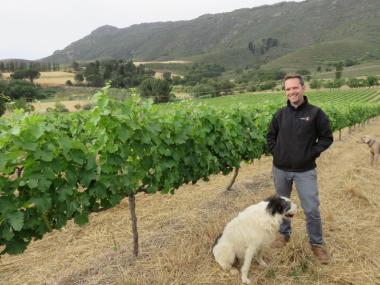
Mullineux & Leeu Family Wines
Andrea, from California, is responsible for production thanks to the technical background in viticulture and oenology acquired at UC Davis (University of California, Davis) and during internships, notably in Châteauneuf-du-Pape. Chris, a native of South Africa, an accountant and business manager, trained later and worked in the south of France and California. Eight people collaborate on this farm.
At Roundstone, the deep ancient schist subsurface - about 500 million years old - is covered with brown shales mixed with quartz, clay and colluvial deposits from the summit of the Kasteelberg mountain (the famous "Table Mountain" which dominates Cape Town). Purchases of grapes from vineyards on decomposed granite of the Paardeberg mountain complete the palette, as well as others, from soils rich in iron oxide and located near Malmesburry.
Given their highly decomposed nature, the soils, usually covered with mulch straw base, are practically not worked because they would fall into dust. Climatic conditions, low rainfall and favorable wind conditions, allow to limit phytosanitary treatments with a systemic from time to time.
The vinification is intended without any artifice, neither additions nor subtractions except sulfur (about 70 mg / l of total for the reds and 80 to 120 mg / l for the dry whites according to the cuvées), in indigenous yeasts without seeding with lactic acid bacteria. For whites, we sometimes note some residual sugars (less than 4 g / l), aging in French barrels or half-barrels. Red wines are poorly peeled and macerate for four to six weeks.
Virtually all the best-known vines grown in France are vinified, and even Portuguese verdelho, but there is a particular interest in chenin and syrah. Three ranges of wines are produced, however the tasting only focused on the upscale "Single Terroir Range" with the exception of the interesting wines of passerillage.
A serious domain where everything seems reflected, framed and built, like the friendly and enthusiastic couple Mullineux. Maybe there is a bit of craziness missing in this almost perfect set?
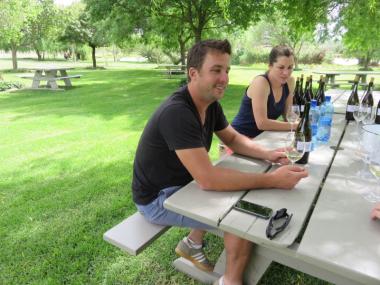
Testalonga
His philosophy is simple: in the vineyard, a biological culture, even biodynamic, favoring the life of the soil and the biodiversity, obviously without any chemistry or irrigation, to force the vine to "fend for itself", which supposes however that the good plant material is planted in the right place!
In winemaking, no artifice except for sulfur, and not always, little extraction, little alcohol and elegant tannins with a frequent search for maceration on skins that develops the tactile aspects, even the minerality. Some might call Craig Hawkins' wines' nature ', but the term here seems too reductive.
On the 2015 vintage, two lines coexist: Baby Bandito on the ease and the freshness and El Bandito with the more built and aromatic wines. In white wines, chenin is very present, without forgetting the muscat of Alexandria and the hárslevelü (Hungarian grape variety). In red, carignan, grenache and syrah predominate, with plenty of fruit and little alcohol, which is good in years when phenolic maturity almost coincides with alcoholic maturity. Note also an effervescent based on verdelho quite successful.
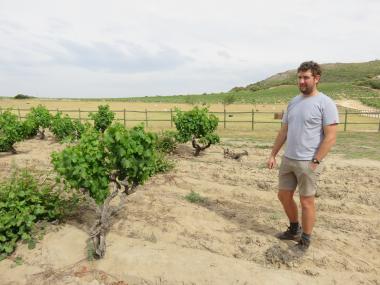
David & Nadia Sadie (Paardebosch)
After working in different places around the world - South Africa, New Zealand, France (northern Rhone and Bordeaux) - back to Swartland where David grew up and started projects. Nadia, his wife, soil specialist, works for the moment only partially to the field while waiting to integrate it full time.
The soils consist of decomposed sand and granite and have a vegetal cover (lupine) in winter. The climate is rather arid and dry so do not use chemicals. Vinification is not very interventionist and only uses sulfur. Four people work on the 16 ha of vines in ownership which include 8.5 ha of Chenin under twenty, 3.5 ha of Pinotage, 2 ha of Semillon aged from forty to sixty-five and 1 ha of Malbec. The purchases concern Rhone grape varieties in both white and red. The two ranges of wines are quite diversified and are not fixed, given the structure of operation. A "young" field to follow!
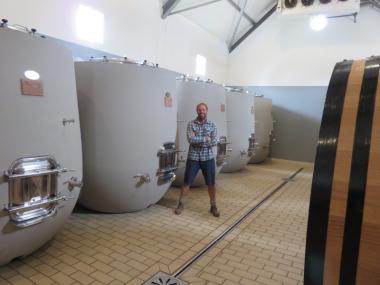
The Sadie Family
We did not know his reputation well and met Eben at a lunch before the opening session of the Swartland Revolution in Riebeek Kasteel, a meal attended by many winemakers, as well as John Platter. Eben was obviously surrounded and recognized by his peers, but his attitude did not suggest to the beholder present (me!) The importance and aura of his field ...
After having worked in different properties in South Africa, notably with Charles Back (SpiceRoute), and elsewhere (Europe, United States ...), he created this estate in the early 2000s. Eben Sadie is mainly a winemaker and breeder. He has practically no vineyards but buys grapes or rent vineyards that he controls, ensuring that they have never been polluted by "chemistry". He practices a biodynamic organic farming, generally without irrigation, with very low yields, of the order of 15 to 18 hl / ha or less. He works on 26 ha and produces just over 30,000 bottles a year under the Sadie Family Wines label.
In particular, we were able to sample the two blend wines, Palladius (nine white grape varieties) and Columella (five Mediterranean red varieties) in 2014, as well as the confidential wines of the "Old Vine Series" range in 2015, made from old vineyards of the coastal region with vineyards sometimes more than centenaries and often frank foot. Among the wines tasted bottled on site, as an example, we were particularly impressed by Mev. Kirsten 2014, a pure chenin of very old vines, the oldest dating from 1906, on decomposed granite, in the Stellenbosch region and whose vinification started with a short carbonic maceration: notes of fruit oils, citrus and a very nice length!
A lot of attention is paid to the vineyard, health status, foliage, exact maturity, harvest conditions, refrigerated transport to the wine equipment ... According to Eben, and his pertinent opinion is shared by many, everything must happen upstream, at vineyard, so no inputs in winemaking, if not sulfur at the usual doses for wines of guard, monitoring, winemaking tailored to the plot and the typology of the vintage. The following containers can be used in winemaking or aging: amphorae, concrete vats, concrete eggs, casks, barrels, but never stainless steel. The breeding has evolved over the years with a gradual decline of new wood to today down to 10%, whether in barrels or casks.
Eben Sadie is a precise, organized and very responsive man who boils about projects like introducing Greek and Sicilian grape varieties ... But some of his wines are sometimes difficult to access to tasting, they need time and aeration for express, and difficult also to acquire because they are rare, so expensive!
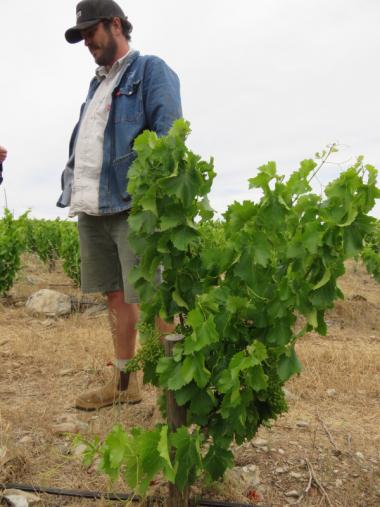
Porseleinberg
Discreet person with the rather reserved aspect, even gruff, in harmony with his farm really located "at the end of the world", Callie is a real man to do everything: preparation of the grounds, plantation, culture and work in biodynamics with the advice of Rosa Kruger, winemaking in whole grapes, with natural yeasts and no inputs, except sulfur, aging in old casks or concrete eggs, never barrels, bottling on site and even printing labels with an old press reconditioned by his care .
If Porseleinberg means porcelain mountain, the [tooltip: Kaolin] (white clay may come from the degradation of granite.) Being especially present in the soil accompanied by blue micro-schists and clays, the arid and dry climate as well as the Desert landscape contradict the fragility induced by the name of the place. The estate comprises 100 ha but barely 20 ha are actually in production with derisory yields. Syrah 95% with some tests of Grenache and Cinsault, and a single red wine (100% Syrah) produced since 2010 under the label Porseleinberg. Initially, the parent company wanted to diversify its necessary supplies to the "Boekenhoustkloof" product range. But it is with the best grapes grown in the Porseleinberg that the wine is made, and Callie retains only about 6000 bottles for its own marketing, the rest going back to the owner, that is to say if the wine is rare .. and so expensive!
In addition to winemaking trials, we were able to taste on-site the 2012, 2013 and 2014 vintages with a beautiful floral evolution for 2012 and a tense, fresh and "sharp" structure for 2013.
Really authentic wines, that some are not wrong to compare to cornas of noble origin, in harmony with this skilful winemaker!
In Stellensbosch district
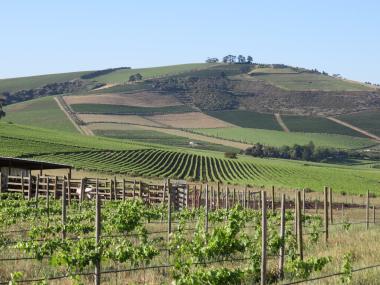
Reyneke
The floors are covered with gravel, clay on a sand structure, and old and poor granite. The vineyard, generally planted at 2.5 m by 1.4 m, dates from the 1980s, with the exception of a few chenin islets from the 1950s. In addition to this grape, Sauvignon is grown on slopes, Syrah and Cabernet Sauvignon. The vines are grassed and the biodiversity is favored thanks to many varieties of plants. Mowing the grass is practiced according to the different species. If necessary, natural fertilizers from the farm are used. Only sulfur is currently used as a preventive and curative treatment, copper having been recently stopped and replaced by a stimulating metabolite of the defenses of the vine to fight against late blight. Biodynamic preparations are added to the compost or applied directly to the vines respecting the natural cycles. Ten people work on the farm, including the maintenance of the cattle herd.
In winemaking, few inputs except, sometimes, vitamins or nutrients to help natural yeasts. As the brand Reyneke, and not the farm, is part of the group [tooltip: Vinimark] (a large distribution group in the wine and spirits sector in South Africa, based in Stellensbosch.), A winemaker of this structure, Rudiger Gretshel , continues to supervise winemaking that is carried out rather in reducing medium in old casks or concrete eggs.
Apart from the two wines tasted collectively in Paris, we especially appreciated on the spot the non-varietal 2015 sauvignon, both fatty and salty, and the Reserve 2013 100% Syrah, floral, fresh but with woody still present. Too bad, however, that the wines, certainly very qualitative, do not always restore the high degree of requirement of the cultural practices!
Leeuwenkuil
Leeuwenkuil was in fact the starting point of this journey. Just arrived from the plane, an assembly tasting awaited us, especially Vincent Carême thanks to whom this trip was possible. The latter had to rule on chenin samples to be selected for its Terre Brûlée 2015 vintages, a preliminary pre-selection of plots of this huge area of 1 250 ha having been made. Remaining a family structure and belonging to the Dreyer family since 1851, the "mother" house is located north of Stellenbosch, but the vineyard runs throughout the Coastal Region, mainly in Swartland. Even if the wines made by this house did not particularly attract us today, Leeuwenkuil is in the course of evolution, especially in terms of the cultural practices which look towards the bio. Conversion tests, to which Vincent Carême is no stranger, are conducted on about 200 ha. To follow, so ...
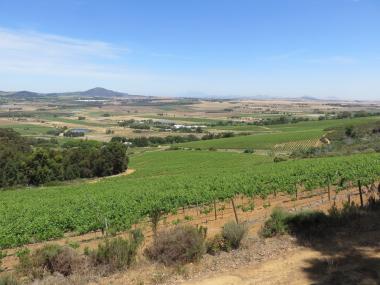
In Paarl
Fairview
Fairview goes well beyond Paarl, as vineyards are also exploited in the Swartland, Darling and Stellenbosch regions, with nearly 580 ha in production, using 40 grape varieties to produce 180 different wines from varied climates: for example, the thermal range varies from 13 to 43 ° between the coast (Darling) and the interior of Swartland during the hot season! Winemaking is under the responsibility of the oenologist Antony de Jaeger, who has been faithful to the job since 1996. The soils, which are generally covered with slate on a granitic base, are very old - 400 to 500 million years old - as is often the case in South Africa. .
Charles Back was one of the first to plant Rhone grape varieties, with wines with the title parodying the Old World wine, Goats do Roam typed Rhone and Bored Doe assembly Bordeaux, a nod to the large local or international clientele. Nevertheless, behind this very commercial facade, the heart of the range or rather the upscale "Limited Release", a dozen wines tasted on site, some also in collective in Paris, is quite qualitative. On the other hand, the committee was not totally seduced by the wines tasted in Paris.
We also visited SpiceRoute, also owned by Charles Back, which is based on the same wine tourism concept as Fairview, but in a more wild environment: it is an old tobacco factory of which about 80 ha have been converted into vines, surrounded scrubland, about 400 ha in total located in Swartland, near Malmsbury. The poorly worked soils of Koffieklip (decomposed granite associated with iron oxide), schistose sands and completely altered granite, vines usually conducted in goblets except for the sauvignon, and a multitude of mainly Rhone grapes, but also tannat and souzao.
Admittedly, the wines produced under the leadership of Charl du Plessis, present since the beginning of the 2000s following Eben Sadie, sometimes seduced us on the spot but less convinced our committee, even at the top of the range: contagious enthusiasm on the spot in the cellar, or mixed welcome of our tasting committee in Paris?
